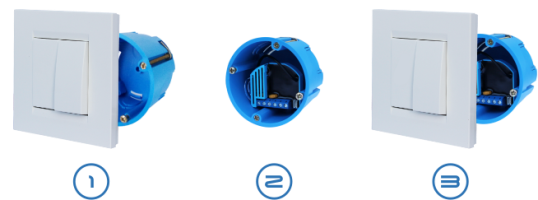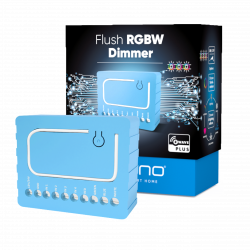Ningún producto
Precios con IVA incluído
Producto añadido correctamente a su carrito de la compra
Hay 0 artículos en su carrito. Hay 1 artículo en su cesta.
Qubino Flush 1 Relay
ZMNHAD1
Nuevo
Micromódulo de 1 relé con control de consumo Qubino Flush 1 Relay para encender/apagar, con tecnología Z-Wave Plus. Se trata de un relé usado para encender o apagar (On/Off - todo/nada) dispositivos eléctricos tales como luces, ventiladores, hornos, lavadoras, planchas, enchufes de potencia, puertas de garaje, radiadores eléctricos, calentadores de agua, etc...
Sin Stock
- Eliminar de mis favoritos
- Agregar este producto a mis favoritos
- Imprimir
Características técnicas
| Tecnología Domótica | Z-Wave Plus |
| Característica | Medición de Consumo |
Descripción
El relé Z-Wave más pequeño del mundo
El Qubino Flush 1 Relay es ideal como interruptor eléctrico para luces, ventiladores, hornos, lavadoras, planchas, tomas de corriente, puertas de garaje, radiadores eléctricos, calentadores de agua, etc. Puede controlarlo remotamente a través de la red Z-Wave o a través de interruptores de pared. También mide el consumo de energía y soporta la conexión de un sensor de temperatura digital.
El relé Z-Wave más pequeño
El relé Z-Wave Qubino Flush 1 Relay es un micromódulo que ocupa menos espacio que cualquier otro modulo con el que se le compare de cualquier otro competidor y encajará fácilmente en cualquier caja de mecanismo convencional.

Este micromódulo Z-Wave Qubino Flush 1 Relay es un relé usado para encender o apagar (On/Off - todo/nada) dispositivos eléctricos tales como luces, ventiladores, hornos, lavadoras, planchas, enchufes de potencia, puertas de garaje, radiadores eléctricos, calentadores de agua, etc...
Este micromódulo de relé oculto, Qubino Flush 1 Relay dispone de una entrada para conectar una sonda de temperatura, lo que lo adecúa para controlar sistemas de calefacción o de aire acondicionado.
¿Para qué se puede usar?
El Qubino Flush 1 Relay es ideal para el control remoto y el cambio de dispositivos eléctricos (por ejemplo luces o ventiladores).
Control energético
El relé simple Z-Wave Qubino Flush 1 Relay, hace medición de consumo eléctrico del aparato eléctrico conectado y de por sí, cuando está en "standby" tan sólo consume 0.4 W.
Muy versátil
El Qubino Flush 1 Relay, puede operar a través de un extenso rango de temperaturas desde los fríos -10˚C a los sofocantes 40˚C (14˚–104˚F). Soporta la conexión de un sensor de temperatura digital, que también es útil para crear escenarios complejos. Cada módulo también actúa como un repetidor con el fin de mejorar el alcance y la estabilidad de la red Z-Wave.
La instalación más sencilla.
El tamaño extremadamente pequeño y una carcasa especialmente diseñada significan que la conexión del módulo dentro de una caja de montaje empotrada es sencillo. El proceso de instalación, probado y aprobado por electricistas profesionales, consta de sólo tres sencillos pasos:
1 - Retire los interruptores de la caja y desconecte los cables.
2 - Conecte los cables al módulo Qubino e insértelos en la caja.
3 - Fije los interruptores a la caja.

Los módulos Z-Wave más probados y más fiables
Los módulos Z-Wave de Qubino son productos de “instalar-y-olvidarte”. Los productos Qubino que te ofrecemos, están fabricados para durar, por lo que sólo utilizan componentes electrónicos que cumplan los más exigentes niveles de calidad. Nuestros módulos además son los micromodulos Z-Wave más testeados del mercado. El Instituto Esloveno de Calidad y Medición (The Slovenian Institute of Quality and Metrology (SIQ)), una entidad europea independiente, comprueba la calidad de los parámetros reales de nuestros productos, incluyendo el aumentos de temperatura, fabricación, resistencia del aislamiento, consumo eléctrico y sobrecargas de acuerdo las normas europeas de la máxima calidad conforme a la especificación del estándar EN 60669-2-1.
Parámetros adicionales para profesionales.
El micromódulo Qubino Flush 1 Relay dispone de 15 parámetros adicionales para su uso por expertos. Algunos de los más útiles son
- Ajuste del tipo mono-estable (pulsador) o bi-estable
- Activar o desactivar las funciones ALL ON / ALL OFF
- Salida de encendido / apagado automático después del tiempo establecido
El micromódulo puede ser controlado tanto a través de una red Z-Wave como a través de un interruptor de pared. Este módulo ha sido diseñado para ser montado dentro de una caja de mecanismo y oculto detrás de un interruptor de pared convencional.
Resaltamos como ventaja respecto a otros reguladores, que el micromódulo Qubino Flush 1 Relay es capaz de controlar el consumo eléctrico de la carga conectada (alumbrado, ventilador...). Además dispone un conector al cual se puede conectar una sonda de temperatura (opcional; no incluida) para dotar de mayor versatilidad a este módulo, que aparte del control de alumbrado, nos ofrece control de consumo eléctrico e información de la temperatura de la estancia en la que se haya instalado.
Esquemas Eléctricos y especificaciones técnicas:


Destacamos que Qubino nos ofrece normas de calidad, seguridad y durabilidad muy estrictas en la fabricación de sus micromódulos ocultos. Hay que señalar la selección de componentes de alta calidad y altas prestaciones, como son el uso de componentes internos de la marca Omron.
| Alimentación: | 110 – 230 VAC ± 10% 50 / 60 Hz, (24–30 VDC) |
| Carga máxima de salida AC (carga resistiva)* | 1 X 10 A / 230 VAC |
| Carga máxima de salida DC (carga resistiva)* | 1 X 10 A / 30 VDC |
| Output circuit power of AC output (resistive load): | 2300 W (230 VAC) |
| Output circuit power of DC output (resistive load): | 240 W (24 VDC) |
| Precisión de la medición de potencia: | P = 5–50 W, +/-3 W P > 50 W, +/-3% |
| Rango del sensor digital de temperatura: | -50° ~ +125°C, resolucion 0.1°C |
| Longitud del cable del sensor digital de temperatura: | 1000 mm |
| Temperatura de Operacion: | -10° ~ +40°C |
| Distancia | hasta 30 m en interior (dependiendo de materiales) |
| Dimensiones (WxHxD) | 41.8 x 36.8 x 15.4 mm |
| (packaging) | (115 x 96 x 22) |
| Peso (incluyendo packaging) | 48 g (64 g) |
| Consumo electrico en standby | 0.4 W |
| Para instalación en cajas de mecanismo | Ø ≥ 60 mm or 2 M |
| Conmutación mediante: | Relé |
* En el caso de cargas distintas de las resistivas, preste atención al valor de cosφ y, si es necesario, utilice una carga inferior a la carga nominal. La corriente máxima para cosφ = 0,4 es 3 A a 250 VAC, 3 A a 24 VDC L / R = 7 ms.
![]()
Descargar
Información Ampliada Z-Wave (Inglés)
Descargue el manual desde aquí.
1. Enable add/remove mode on your Z-Wave gateway (hub)
2. Connect the device to the power supply (with the temperature sensor already connected – sold separately*).
3. Auto-inclusion will be initiated within 5 seconds of connection to the power supply and the device will automatically enrol in your network
MANUALLY ADDING THE DEVICE TO A Z-WAVE NETWORK (MANUAL INCLUSION)
1. Enable add/remove mode on your Z-Wave gateway (hub)
2. Connect the device to the power supply (with the temperature sensor already connected*)
3. Toggle the switch connected to the I1 terminal 3 times within 5 seconds
OR
If the device is powered by 24 V SELV supply, press and hold the S (Service) button between 2 and 6 seconds
4. A new multi-channel device will appear on your dashboard
*If connecting the temperature sensor, switch off the power supply and make sure the device is excluded from your network BEFORE connecting the sensor.
*Make sure the device is excluded from your network before connecting the temperature sensor. Switch off the power supply, connect the temperature sensor, and re-include the device to your network.
1. Connect the device to the power supply
2. Make sure the device is within direct range of your Z-Wave gateway (hub) or use a hand-held Z-Wave remote to perform exclusion
3. Enable add/remove mode on your Z-Wave gateway (hub)
4. Toggle the switch connected to the I1 terminal 3 times within 5 seconds
OR
If the device is powered by 24 V SELV supply, press and hold the S (Service) button between 2 and 6 seconds
5. The device will be removed from your network but any custom configuration parameters will not be erased
1. Connect the device to the power supply
2. Within the first minute (60 seconds) the device is connected to the power supply, toggle the switch connected to the I1 terminal 5 times within 5 seconds (5 times change switch state)
OR
If the device is powered by 24 V SELV supply, press and hold the S (Service) button for more than 6 seconds
*By resetting the device, all custom parameters previously set on the device will return to their default values, and the owner ID will be deleted. Use this reset procedure only when the main gateway (hub) is missing or otherwise inoperable.





























